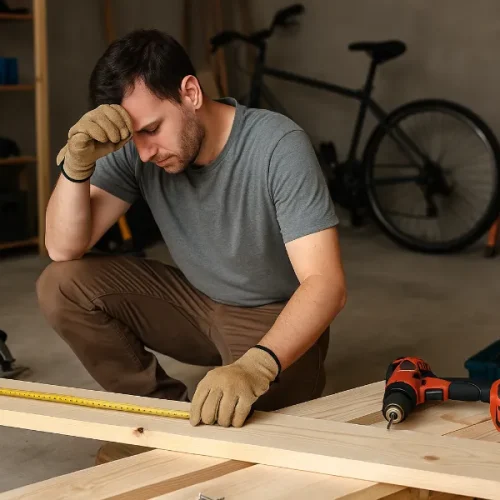
Imagine the chaos: you’re trying to navigate a 26-foot rented truck down I-35, listening to your antique dresser rattling in the back, and praying you’ll make it to Dallas before your friends’ goodwill (and energy) runs out.
Now, picture this: You’re sipping coffee as a professional team, your “heavy-lifting contractors,” expertly load your perfectly organized, color-coded boxes. You’ve handled the “build,” and now you’re letting the pros install the “foundation.”
This guide is for the handy, organization-obsessed homeowner. As Austinites, we love our homes, from the quiet lakeside suburbs of Lakeway and West Lake Hills to the bustling family neighborhoods of Round Rock. We love a good project.
But when that project is a long-distance move, it’s a different beast. This isn’t a small weekend task. This is a “boss-level build,” especially if your plans are taking you to a new Texas metroplex.
We’ll walk you through how to “blueprint” your relocation, select the right high-performance “components,” and why your most critical tool is the right professional partner.
Why Treat Your Move Like a DIY Project?
The “DIY” approach to moving doesn’t mean you have to do the back-breaking labor. It means you take control of the project’s design.
The primary advantage is unparalleled efficiency. You are the “Project Manager.” You control the inventory, the purging (goodbye, clutter!), the packing, and the timeline. This is the single biggest home organization project you will ever tackle.
But every smart “builder” knows which parts of the job to subcontract. You wouldn’t try to pour your own concrete foundation, would you? In moving, the “foundation” is the physical transport—it’s the highest-risk, heaviest-lift component. This is where you call in the specialists.
Selecting Your “Technical Components”
The heart of your project is the “tech” and “gear” you choose.
- Your “Software” (The DIY Part): This is your system. Your spreadsheets. Your label maker. Your color-coded packing tape. This is where you get to shine and let your organization skills run wild.
- Your “Hardware” (The Pro Part): This is the muscle, the truck, the insurance, and the logistics. This component must be flawless.
For our project, we selected Iron Grip Movers as our “hardware” provider. Why? Because their system scales. They are the specialists, whether you’re moving from Lakeway to downtown or tackling one of the two biggest projects of all.
The “Boss-Level” Builds: Austin to Dallas & Austin to Houston
A local move within the Austin area is one thing. But a major long-distance move from Austin to Dallas or Houston? That is a different league.
This isn’t just “moving your stuff.” This is a complex logistical operation. You can’t “make a second trip” if you forget something. The risk of damage from a 3-5 hour journey on a bumpy highway is exponentially higher. The cost of a “Full DIY” error (like a truck breakdown on I-35) can wipe out any potential savings.
This is where the DIY-pro mentality clicks: you recognize your limits and hire a specialist for the heavy hauling.
The Iron Grip Movers team specializes in these high-stakes routes. They are our “heavy-equipment contractors.”
Step-by-Step Project Blueprint: Calibrating Your Route
Like any home improvement project, you need a blueprint. Here’s how to “calibrate” your plan for a long-distance build.
Step 1: The “Dallas Build” (Austin to Dallas) This is the I-35 gauntlet. It’s hundreds of miles of high-speed, high-traffic trucking. Your “hardware” (the moving team) must be built for this endurance run, ensuring your “software” (your carefully packed boxes) arrives intact. This requires a specific blueprint.
- Our Key Planning Resource: We started with their detailed guide, which helped us understand the specific timeline and logistics. You can find that blueprint here: The Austin to Dallas Moving Guide.
Step 2: The “Houston Build” (Austin to Houston) This route (hello, Highway 290!) presents its own challenges: the infamous Houston humidity and unpredictable traffic. Your furniture doesn’t just need to be moved; it needs to be protected. Again, your DIY packing is 50% of the solution. The other 50% is how professionally the “hardware” performs on game day.
- Our Key Planning Resource: The logistics of entering and navigating Houston are different. We used this plan to prepare: The Austin to Houston Moving Guide.
Budgeting Your Relocation “Build”
Every great DIY project has a budget.
- Full DIY (Low-Budget, High-Risk): You, a rental truck, and your (soon-to-be-sore) friends. Fine for a local move in Austin, but a massive gamble for Dallas or Houston.
- Hybrid/Smart DIY (Best ROI): This is our method. You perform all the skilled, “clean” labor: organizing, purging, packing. You hire Iron Grip Movers for the “dirty” work: the heavy lifting, the long-distance driving, and the unloading. This is the best Return on Investment for your sanity and your belongings.
- “White Glove” (High-Budget): You don’t lift a finger. The pros pack everything for you. A great luxury, but where’s the DIY fun in that?
Conclusion: Time to “Measure Up”
Transforming your Austin home—whether it’s in a lakeside suburb or a downtown condo—into a pile of boxes is a daunting task. But when you reframe it as your biggest DIY project yet, everything changes.
The journey starts with a simple measurement. Scope out your project. What’s your inventory? What’s your route? If your blueprint points you to Dallas or Houston, your first step isn’t buying boxes. Your first step is booking your “General Contractor.”
Grab your label maker; your new home is waiting.
FAQs
A local move (even from suburbs like Lakeway or Round Rock) is typically billed by the hour. A long-distance move, like to Dallas or Houston, is a fixed-cost project based on inventory weight and distance. It requires far more planning and more robust “hardware.”
Absolutely! That’s the “Hybrid/Smart DIY” method we recommend. You use all your own organization hacks to pack, and they provide the professional muscle and transportation. It’s the best way to save money without breaking your back.
For “boss-level” projects like these long-distance moves, book as early as possible. We recommend at least 4-6 weeks out, especially if you’re moving during the peak summer season. It’s the most critical “component” of your build—lock it in first.
This is on you, the “Project Manager.” Your job is to pack them better than anything else. Use more padding than you think you need. Label those boxes clearly and on all sides. A professional team like Iron Grip Movers is trained to identify and handle these “high-value” items with extra care.













